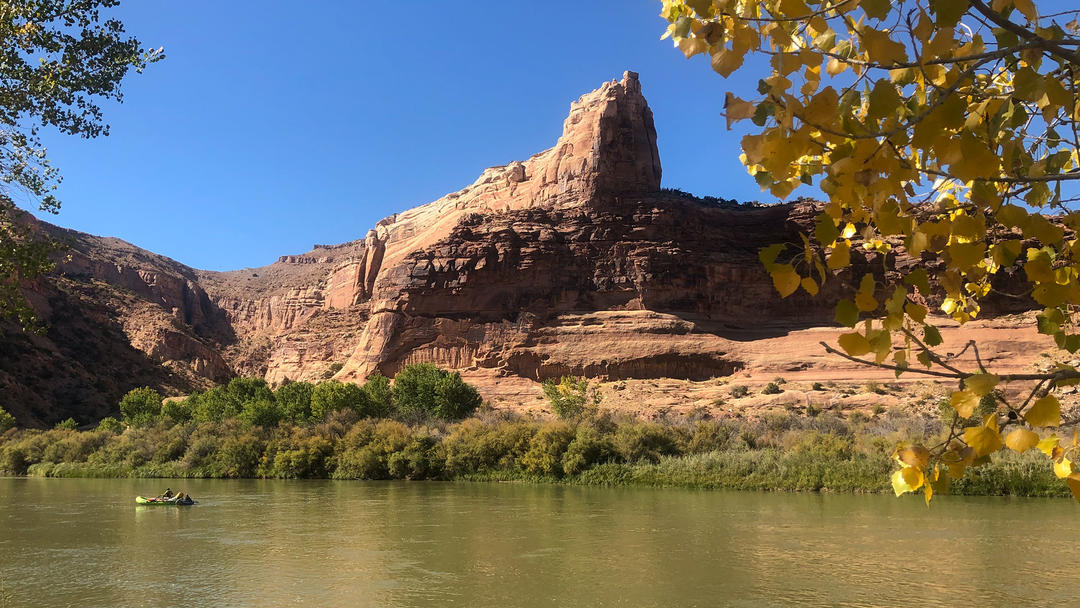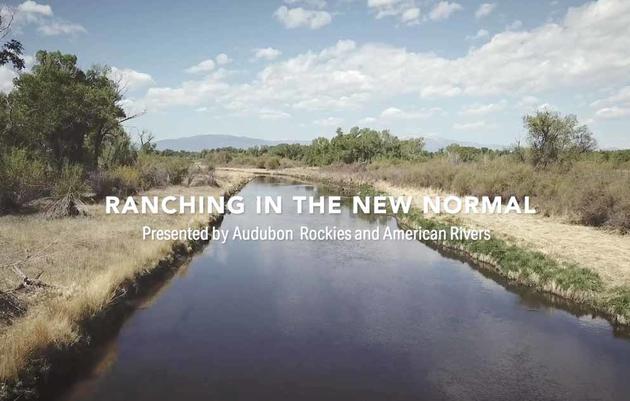October 1st kicked off the new water year. This is when water managers and water wonks focus on existing water supplies and precipitation predictions. Water years run from October 1st through the following September 30th, and Water Year 2020 is poised to be one we will all be talking about for years to come. During it, we’ll see the start of discussions around the agreement that needs to be reached in 2026 to replace the Colorado River Interim Operating Guidelines, further investigation of a potential Upper Colorado River Basin demand management program after the adoption of the Drought Contingency Plans in 2019, and the launch of the first update to Colorado’s Water Plan. It’s a dynamic time for both Colorado River and Colorado water management!
Abby Burk, western rivers regional program manager for Audubon Rockies, reached out to Becky Mitchell—director of the Colorado Water Conservation Board (CWCB) and Colorado commissioner on the Upper Colorado River Commission—to ask six key questions and learn how she’s leading Colorado through these water milestone moments.
Q: Water is such a broad issue that connects all of us. Colorado’s Water Plan, completed in 2015, is four years old. What have been the plan’s successes and challenges? What is your most celebrated Water Plan implementation project?
A: At the CWCB, we work every day to implement the Water Plan, and because of that, I would call the plan’s biggest success its ability to bring all of the important projects and programs that the agency does into better focus with a cohesive whole. In fact, far beyond the CWCB, the Water Plan continually helps to unite countless efforts occurring throughout the state at every level of the public, private, and nongovernmental sphere. While it will always be an ongoing and iterative process, the concrete goals and objectives of the Water Plan have really helped to motivate our community to collectively address our (many) water challenges, which include maintaining momentum, coordinating efforts at every level, and continually funding the innovative and effective projects.
While it’s hard to pick just one example of a celebrated project, the first one that comes to mind is the Homestake Arkansas River Diversion Project. Currently under construction, this project is managed by the City of Aurora and Colorado Springs Utilities to improve the reliability of a major aging diversion structure while at the same time removing the last critical barrier to boat and fish passage on the Upper Arkansas River and restoring important habitat. The CWCB contributed $700,000 to help fund the project, along with funding from Colorado Parks and Wildlife, various other project supporters, and donated easements from the Pueblo Board of Water Works, totaling $7.7 million.
Q: Water is a critical issue for all Coloradans. Whether you play in/around our world class rivers, irrigate your crops, or take a sip of our abundant clean drinking water, our valuable and limited water supply impacts each of us every day. How will the Water Plan keep pace with a growing Colorado and protect what makes Colorado so special: our rivers?
A: From day one, the Water Plan has been a living document. The plan is fundamentally a broad ongoing effort to collectively meet our state’s evolving water challenges in the most effective and mutually beneficial ways. To keep pace with a growing Colorado, Chapter 11 of the plan sets the process for continually refreshing the plan. We have now unified all of the Water Plan components into three main pillars: the main Water Plan (the primary policy document), the Basin Implementation Plans (the local application of the plan), and the Analysis and Tech Update (the plan’s technical foundation). In summer 2019, we finalized the Tech Update and are now updating the Basin Implementation Plans and the Water Plan to support the Tech Update.
A critical aspect of all of these efforts is protecting our special rivers. The Tech Update included the development of an environmental flow tool to help interpret how potential future stream conditions may change, and how to plan for those impacts. We hope this tool and the wealth of other data in the Tech Update will better inform local efforts to address environmental needs, starting with updated analyses in the Basin Implementation Plans.
Q: This is an exciting time for Colorado River water management with the passage of the Drought Contingency Plan (DCP) and the ramp up to the renegotiation of the 2007 interim guidelines in 2026. Considering the DCP, how are you leading Colorado’s place in exploring a possible demand management program? How is Colorado working with other Upper Basin states in looking at options for demand management?
A: The CWCB has taken two major policy actions regarding a potential demand management program. First, the board passed a support and policy statement back in November, 2018. This statement took into account public comments, stakeholder and water user concerns, as well as board guidance and support for the draft DCPs. This was aimed at guiding the assessment of demand management feasibility.
The board also adopted the 2019 Work Plan in March of this year. This Work Plan represents the first steps toward assessing demand management feasibility as identified in the support and policy statement. The Work Plan tasks CWCB with setting up workgroups to help identify priority issues regarding demand management and holding public regional workshops to garner input and discussion. It also directs the legal, technical, and policy investigations that will inform the Board’s next moves in determining whether a demand management program is appropriate for Colorado.
We communicate regularly with our Upper Basin state partners on their own intrastate efforts to assess demand management feasibility, who are all engaged in similar processes within their borders. As the intrastate investigations continue, the Upper Basin states will share information through the auspices of the Upper Colorado River Commission and their committees to further assess the feasibility of demand management across borders and throughout the Upper Basin.
Q: We have to acknowledge that storage is a part of our water portfolio future. However, none of us have an appetite for big new reservoirs. What are ways that storage can be leveraged for fulfilling the growing needs of water certainty while still supporting Colorado’s healthy rivers?
A: Without sufficient water storage, the vast majority of our current population could not live in this environment; and with a growing population, we will very likely need some additional storage. However, we also need to more effectively manage our existing infrastructure to support healthy rivers.
Examples of this include iterative efforts to re-operate the Ruedi and Chatfield Reservoirs to meet multiple needs, and in the case of Chatfield, to increase storage without raising the dam. Another example is the South Platte Regional Opportunities Water Group, which is currently conducting a feasibility study to examine aquifer storage and recharge, off channel reservoirs, and storage of municipal reuse water, among other things.
Q: What’s your message for people who care about Colorado’s rivers, and the birds and wildlife they support? How will the state take care of its rivers as climate change increases the frequency and intensity of droughts?
A: The takeaway message here is healthy rivers are vital to Colorado’s conservation efforts and quality of life, and the CWCB is committed to maintaining those stream flows for all fish and wildlife that depend on them as well as for the enjoyment of our outdoor recreationists.
More specifically, the CWCB works with partners on appropriating new instream flow water rights to maintain stream flows that support Colorado’s fish, birds, and wildlife and the food and habitat that they need. Particularly in dry years, we work with the Colorado Water Trust, other nonprofit organizations, and water rights owners on leases and other mechanisms for providing and protecting stream flows.
In last year’s example of the Coats Brothers Ditch temporary lease on Tomichi Creek, the ditch owners used the water right for irrigation until July 1, when the CWCB started using it for the Tomichi Creek instream flow water right. This lease provided approximately 202 acre-feet of water to the stream during low flow conditions while providing an economic benefit to the ditch owners. This type of flexible tool is very effective at addressing low flow conditions.
In the face of climate change, which we know will present unique challenges to protecting our rivers and streams, we are committed to finding ways to address those challenges, including working with groups who have identified needs and opportunities in their stream management plans to implement additional stream protection.
Q: What is the one thing that gives you the most hope about where we are heading with water in Colorado?
A: We have engaged stakeholders who care deeply about maintaining the Colorado way of life and the values in the Colorado Water Plan. These stakeholders work with the CWCB, the basin roundtables and communities every day to collaboratively plan for our future and implement projects that drive the Colorado Water Plan forward. These efforts forge partnerships, remove barriers, inspire new generations and encourage a spirit of cooperation that is so important to building multi-purpose, multi-benefit initiatives that meet multiple water needs for farms, urban communities and the environment.
For the Water Plan to be successful, we need to balance all of these needs. Our stakeholders are the lifeblood of Colorado water planning and they serve as a shining example of what public engagement can accomplish.









